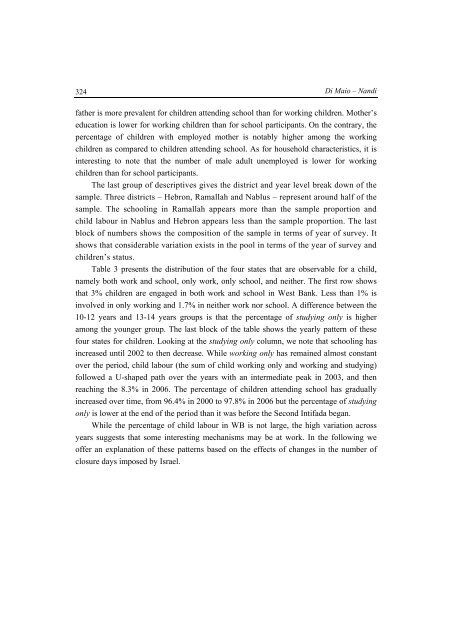The Palestinian Economy. Theoretical and Practical Challenges
The Palestinian Economy. Theoretical and Practical Challenges
The Palestinian Economy. Theoretical and Practical Challenges
You also want an ePaper? Increase the reach of your titles
YUMPU automatically turns print PDFs into web optimized ePapers that Google loves.
324<br />
Di Maio – N<strong>and</strong>i<br />
father is more prevalent for children attending school than for working children. Mother’s<br />
education is lower for working children than for school participants. On the contrary, the<br />
percentage of children with employed mother is notably higher among the working<br />
children as compared to children attending school. As for household characteristics, it is<br />
interesting to note that the number of male adult unemployed is lower for working<br />
children than for school participants.<br />
<strong>The</strong> last group of descriptives gives the district <strong>and</strong> year level break down of the<br />
sample. Three districts – Hebron, Ramallah <strong>and</strong> Nablus – represent around half of the<br />
sample. <strong>The</strong> schooling in Ramallah appears more than the sample proportion <strong>and</strong><br />
child labour in Nablus <strong>and</strong> Hebron appears less than the sample proportion. <strong>The</strong> last<br />
block of numbers shows the composition of the sample in terms of year of survey. It<br />
shows that considerable variation exists in the pool in terms of the year of survey <strong>and</strong><br />
children’s status.<br />
Table 3 presents the distribution of the four states that are observable for a child,<br />
namely both work <strong>and</strong> school, only work, only school, <strong>and</strong> neither. <strong>The</strong> first row shows<br />
that 3% children are engaged in both work <strong>and</strong> school in West Bank. Less than 1% is<br />
involved in only working <strong>and</strong> 1.7% in neither work nor school. A difference between the<br />
10-12 years <strong>and</strong> 13-14 years groups is that the percentage of studying only is higher<br />
among the younger group. <strong>The</strong> last block of the table shows the yearly pattern of these<br />
four states for children. Looking at the studying only column, we note that schooling has<br />
increased until 2002 to then decrease. While working only has remained almost constant<br />
over the period, child labour (the sum of child working only <strong>and</strong> working <strong>and</strong> studying)<br />
followed a U-shaped path over the years with an intermediate peak in 2003, <strong>and</strong> then<br />
reaching the 8.3% in 2006. <strong>The</strong> percentage of children attending school has gradually<br />
increased over time, from 96.4% in 2000 to 97.8% in 2006 but the percentage of studying<br />
only is lower at the end of the period than it was before the Second Intifada began.<br />
While the percentage of child labour in WB is not large, the high variation across<br />
years suggests that some interesting mechanisms may be at work. In the following we<br />
offer an explanation of these patterns based on the effects of changes in the number of<br />
closure days imposed by Israel.
















